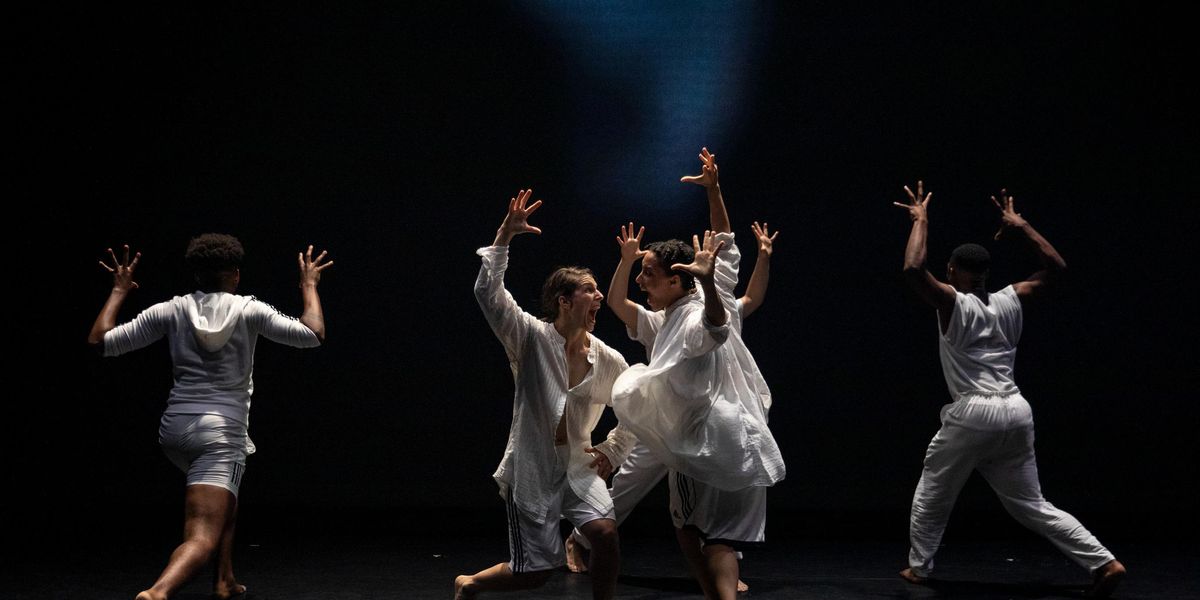Learning to Speak Onstage Doesn't Have to Be Scary
When Elizabeth DeMent joined Big Dance Theater, she found herself dropped into a foreign realm where voicework was considered part and parcel of each production. A graduate of The Juilliard School with credits like the Metropolitan Opera Ballet, Liz Gerring Dance Company and Patrick Corbin, DeMent felt like a fish out of water in the experimental-dance/theater amalgam headed by choreographer Annie-B Parson. “I grew up in a classical paradigm where the only vocal work we did was a silent scream where we just opened our mouths,” says DeMent. In her early days with the company, her voice came out strained and from her throat, and she had to learn to speak from a supported place.
Few dance techniques include voicework in their formal training. Yet it’s becoming more and more common for choreographers to ask dancers to speak onstage, and voicework has always been required in musical theater. As the dance world evolves to allow for a more holistic understanding of the body, it’s paramount for dancers to develop the confidence and tools to see their voice as part of their artistic instrument.
Begin With Breath
Breathing is fundamental to voicework. According to Kay Cummings, who taught acting and choreography at NYU’s Tisch School of the Arts for decades, the use of breath can be thought of as a continuum that ranges from the throat to fuller diaphragmatic breaths in the middle and lower torso. Speaking and singing require a different use of the diaphragm than dancing, she says, and dancers may be used to breathing shallowly since they’re using other muscles to support the core. Speaking and dancing at the same time, then, can require some adjustments. In some cases it’s helpful to think of breathing in the middle of the continuum, says Cummings.
DeMent says that after attending a breathing workshop, she spent hours lying alone on the floor of her apartment, humming to learn to feel the vibrations lower in her abdomen. “I realized that my ballet technique was in conflict,” she says. “You can’t pull up and relax your abdominals at the same time.”
Let Go of Self-Consciousness
When first asked to speak or sing, many dancers feel burdened by inhibitions. Choreographer David Dorfman, who frequently uses voicework in his company’s repertoire, urges students to remember that it isn’t as foreign a concept as it seems. “How many times do people go on a walk with a friend and tell stories?” he says. A professor at Connecticut College, Dorfman likes to open classes with simple pedestrian movement, walking around the studio to loosen the body while verbally greeting students along the way.
“I don’t think there’s anything more vulnerable for a dancer than using your voice,” says DeMent. Big Dance Theater co-founder Paul Lazar once gave her a 12-minute vocal workout to help her prepare for a play he was directing, which years later she still does most days. It includes everything from a sustained “shhhh” sound to “little puppy pants,” which requires DeMent to pant with her tongue hanging out. “I learned to make ugly sounds,” she says. “Once I had more confidence it became easier to do, and then snowballed until it became enjoyable.”
Now when working with students, DeMent encourages them to see the humor in the process and push beyond their shyness. She often starts workshops with vigorous shaking. “I just want them to shake off all that training and all that preciousness until they can’t be self-conscious,” she says. “I think it’s really liberating.”

Scott Shaw, courtesy DeMent
Find Meaning in What You’re Saying
Cummings believes that if a dancer is connected to what they’re saying, the rest will flow naturally. “When text means something, you can focus on being a real person talking to real people,” she says. This idea is implicit in Dorfman’s process: Early on in creating a piece, he gives his company members a writing prompt, which they are often asked to combine with a movement phrase. He credits this way of working with his dancers’ sense of comfort speaking onstage. “They’re not learning a monologue that exists in the world. They’re writing their own text that comes from within, so they already have shadings and qualities that they express without ever having to be coached,” he says. This quotidian quality also keeps dancers from over-projecting, falling into what Dorfman calls the “sports-announcer voice.”
If you are tasked with working from a script, read the text closely to find areas you can connect to emotionally. This tactic can also help when choosing a monologue or song to perform at theater auditions. “If you have to sing eight bars, choose bars where the lyrics mean something to you, so that it’s more than a syllable to hang a note on,” says Cummings.
Practice Full-Body Integration
Looking back, DeMent wishes that she’d incorporated voicework into her dance training from a much earlier age. “A vocal warm-up is just as important as a physical warm-up,” she says. “You’ve got to roll your ankles and warm up your feet, and you’ve got to warm up the energy channel where your voice comes from, even if you don’t need to use it in your performance.”
DeMent has found that preparing her whole being helps her to be more present onstage. Cummings agrees that confidence in one’s voice can hugely benefit dancers whether they’re being asked to speak onstage or not. “Dancers are often trained not to speak up,” she says. “But the more you expose yourself, the more vulnerable you are, and vulnerability’s not weakness; it’s strength.”
Teachers: For tips on helping your students use their voices, visit dance-teacher.com





